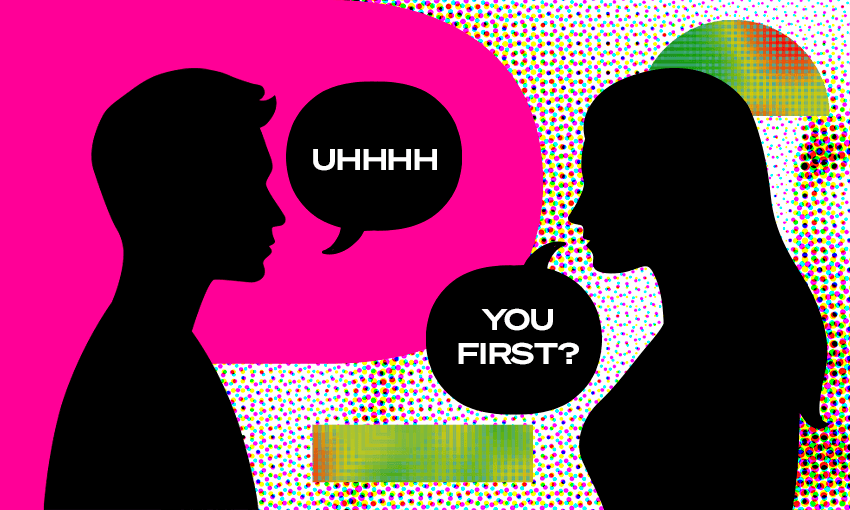Porn plays a positive role in many couple’s sex lives – and a hurtful, secretive, damaging role in others. The key to avoiding the latter scenario is honesty and communication, writes sex and relationships coach Michelle Kasey.
All this week on The Spinoff we’re talking about porn. Click here for more Porn Week stories.
I remember the first time I watched pornography like it was yesterday. I was 18 and using my then-boyfriend’s computer for an assignment. I noticed a mysteriously labelled folder on his desktop which sparked my interest. I opened it to find a humble selection of pirated pornos.
I felt the uprising of rebellious anticipation in my chest as I opened the first file. It was a vintage film featuring disco bushes, handlebar moustaches and passionate scenes atop pool tables. I felt dopamine rolling through my body as my brain reacted to the most sexual stimuli it had ever been exposed to at once. I had never felt a high like this.
As a global community, we’ve been trying to figure out if porn is good, bad or even neutral for some time. Western psychology has offered us warnings about porn addiction and studies about its neurological impacts. We’ve had conversations about how porn has done a terrible job of educating us about sex, even though the adult entertainment industry never set out to reeducate our sex-negative society.
Throughout my career, I’ve spoken to thousands of people about the impact that watching porn has made on their lives. I’ve seen that, like most things, it’s not black and white. While porn is not inherently bad, you can form both healthy and unhealthy relationships with it. I’ve worked with clients who felt sexual liberation from watching porn to normalise sex and diverse bodies. Some have learned more about their sexual needs, wants and desires through pornography, and brought more pleasure and orgasms into their lives through watching it.
On the flip side, I’ve also worked with clients with an unrealistic view of sex informed by porn. I’ve met people who have felt unable to become sexually aroused without watching porn. Some have felt addicted to the dopamine rush porn elicits and would find themselves watching while driving, working, even showering. Others felt disconnected from their bodies during sex because they’d rarely experienced their sexual pleasure without a screen, or were so seduced by the instant gratification of porn and didn’t want to invest time in finding a real sexual partner.
Personally, I’ve experienced liberation, pleasure and inspiration from watching porn. I’ve also felt disconnection, dullness and dissatisfaction in my sex life when I’ve consumed it too often. I’ve found it can be helpful to think of porn as sexual fast food. Eating KFC occasionally can be a glorious, greasy, pleasureful treat. But if you were to eat it for every single meal, your energy levels would drop, your wellness would be impacted and you’d feel increasingly less satisfied with and nourished by your diet. The same goes for your sexual wellness.
Many of us learned to leave no trace when it comes to porn. Deleting your browser history is the masturbation finale. However, I’ve seen that an increasing number of people are wanting to talk to their partners about porn. This makes sense, it’s become the third person in most modern relationships.
While having courageous conversations with your partner about porn can be intimidating, it can be an important ingredient in creating a fulfilling sex life together. Conversations about sex and porn can bring up challenging emotions. Shame, guilt, resentment, and feelings of betrayal. It can also be super sexy and deeply connecting to be open with a partner about your sexual needs, curiosities and desires.
If you’ve typically avoided having honest conversations about sex, it’s normal to feel awkward and be a little clunky in your delivery as you begin to shine a light on what’s sitting in the shadows.
Tips on talking about porn
Start with your why. A good place to start is to get clear on why you want to talk about it. Are you wanting to be able to be more transparent about porn use to better understand one another? Do you have the desire to watch it together? Are you feeling worried about your/their porn use? Is a need you have in your relationship going unmet? Are you wanting to discuss being a conscious consumer of ethical feminist porn?
If the topic of pornography brings up difficult feelings for you, process them beforehand. Express it in your journal, offload with a professional, ask a friend who relates to hear you out, or take your feels into a sweaty workout. This will help you stay grounded throughout the conversation.
Practice the conversation out loud. This can sound geeky, but when you do it you’ll quickly realise how valuable it is. I find driving my car or showering a great opportunity for talking to an imaginary partner.
No blaming, shaming or taming. These are crude instruments for creating change as a couple. When you practice letting go of judgement and lean into compassionate curiosity, you’ll notice it’s easier for you both to stay open to one another. When we feel judged, we’re likely to shut down.
Practice staying grounded. Talking about porn can be triggering. Stay grounded by breathing slowly and deeply into your belly and imagining that you’re growing roots down into the earth. We can’t engage in relationship conversations effectively when we’re in fight, flight, freeze or fawn.
Give high-quality information. Things that are obvious to us aren’t necessarily obvious to our partners. Be patient and generous in helping your partner understand your experience/needs/desires and visa versa. Remember that as lovers, you are on the same team.
Send them this article. Hi, hello, your partner wants to talk about porn with you but doesn’t know where to start.


